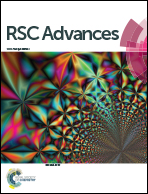Preparation of ultrahigh-molecular-weight polyethylene grafted with polyvinyl alcohol hydrogel as an artificial joint
Abstract
A chemical grafting method was used to graft UHMWPE with PVA hydrogel to be used as an artificial joint. The effects of temperature, grafting time, catalyst amount and grafting solution concentration were studied by orthogonal experiments. The results showed that active groups were formed on the UHMWPE surface on using dichromate for oxidation, and then a chemical graft occurred using the catalyst to catalyse hydroxyls in the PVA hydrogel molecules and surface active groups of UHMWPE. The optimum reaction conditions were as follows: 1% concentrated sulphuric acid as catalyst, 2.5 h reaction time and 85 °C temperature. The shear strength of the artificial joint can reach 1 MPa. The contact angles of UHMWPE are decreased from 104° to 39° by grafting and the surface wettability is effectively improved.


 Please wait while we load your content...
Please wait while we load your content...